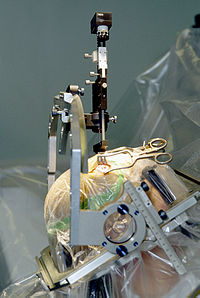
Photo from wikipedia
PurposeTo analyze endoscopic vitreoretinal surgery principles, applications, challenges and potential technological advances.BackgroundMicroendoscopic imaging permits vitreoretinal surgery for tissues that are not visible using operating microscopy ophthalmoscopy. Evolving instrumentation may overcome… Click to show full abstract
PurposeTo analyze endoscopic vitreoretinal surgery principles, applications, challenges and potential technological advances.BackgroundMicroendoscopic imaging permits vitreoretinal surgery for tissues that are not visible using operating microscopy ophthalmoscopy. Evolving instrumentation may overcome some limitations of current endoscopic technology.AnalysisTransfer of the fine detail in endoscopic vitreoretinal images to extraocular video cameras is constrained currently by the caliber limitations of intraocular probes in ophthalmic surgery. Gradient index and Hopkins rod lenses provide high resolution ophthalmoscopy but restrict surgical manipulation. Fiberoptic coherent image guides offer surgical maneuverability but reduce imaging resolution. Coaxial endoscopic illumination can highlight delicate vitreoretinal structures difficult to image in chandelier or endoilluminator diffuse, side-scattered lighting. Microendoscopy’s ultra-high magnification video monitor images can reveal microscopic tissue details blurred partly by ocular media aberrations in contemporary surgical microscope ophthalmoscopy, thereby providing a lower resolution, invasive alternative to confocal fundus imaging. Endoscopic surgery is particularly useful when ocular media opacities or small pupils restrict or prevent transpupillary ophthalmoscopy. It has a growing spectrum of surgical uses that include the management of proliferative vitreoretinopathy and epiretinal membranes as well as the implantation of posterior chamber intraocular lenses and electrode arrays for intraretinal stimulation in retinitis pigmentosa. Microendoscopy’s range of applications will continue to grow with technological developments that include video microchip sensors, stereoscopic visualization, chromovitrectomy, digital image enhancement and operating room heads-up displays.ConclusionMicroendoscopy is a robust platform for vitreoretinal surgery. Continuing clinical and technological innovation will help integrate it into the modern ophthalmic operating room of interconnected surgical microscopy, microendoscopy, vitrectomy machine and heads-up display instrumentation.
Journal Title: International Journal of Retina and Vitreous
Year Published: 2019
Link to full text (if available)
Share on Social Media: Sign Up to like & get
recommendations!